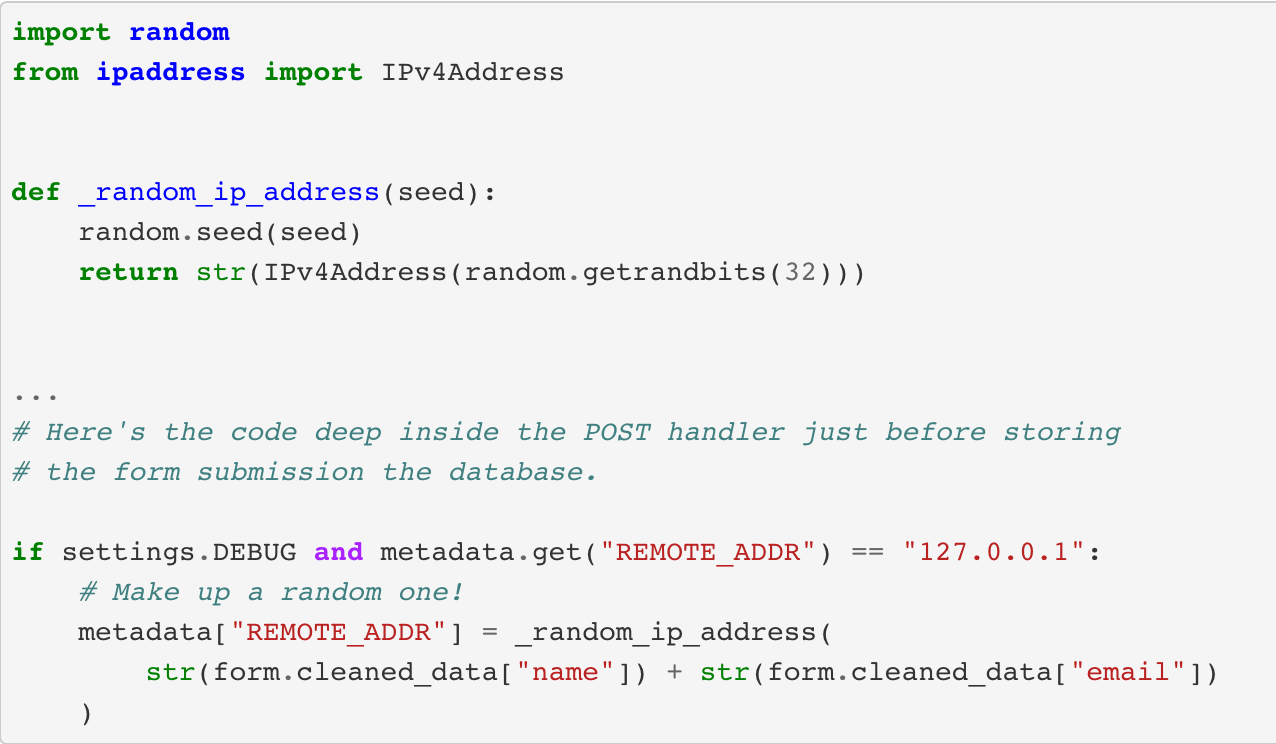
- #RANDOM DATA GENERATOR PYTHON HOW TO#
- #RANDOM DATA GENERATOR PYTHON INSTALL#
- #RANDOM DATA GENERATOR PYTHON CODE#
- #RANDOM DATA GENERATOR PYTHON SERIES#
This library, along with NumPy and many other data-oriented libraries, illustrates the strong support that continues to keep Python among the most popular programming languages out there.
#RANDOM DATA GENERATOR PYTHON SERIES#
Random Time Series data can help sidestep the hurdle of having to sanitize and clean data before trying out new methods of analysis.Īfter all, the quickest way to kill your buzz over that new machine learning library is to have to pause for an hour while you prepare your data for a test drive! Fortunately, pandas make short work of such data needs. Random data is very convenient for testing new algorithms, getting up and running fast in an unfamiliar programming environment, and for making quick visualizations. Parameters : This method does not accept any parameter. It takes no parameters and returns values uniformly distributed between 0 and 1.

In a random module, you get two methods randint(start, end) and randrange(start, end, steps). (See the opening and closing brackets, it means including 0 but excluding 1). Generating random numbers with Python random module. With that in mind, let’s take a look at this random Time Series data we’ve just generated: A plot of the random integers paired with Month-based matching to our random Time Series Final Thoughts random.random () function generates random floating numbers in the range 0.1, 1.0). There’s a time and place for generating random numbers, like assignments during random sampling, but not often for analysis.
#RANDOM DATA GENERATOR PYTHON CODE#
The data entered here would obviously be something relevant to the domain one was testing. If you generate your random numbers in Python, use the seed() function by passing in an integer value: ed(1) pass in an integer value as the seed random.sample(range(0, 32), 5) 8, 4, 16, 7, 31 The above code snippet will always generate the same list of random numbers. This adds a new column of randomly generated integer values to our data.


Series = np.random.randint(0, 42, size=(len(series))) This is done as such: # Add a column of random integers to each date entry Fortunately, pandas is deeply integrated with NumPy and can leverage that module to create some random data to associate with the Time Series with relative ease. The example above creates a dummy Times Series sequence but without data, it isn’t very useful. # Generate series from start of 2016 to end of 2020
#RANDOM DATA GENERATOR PYTHON HOW TO#
In this quick example, you’ll learn how to generate a sample set of Time Series data to load as a Pandas Dataframe for whatever purpose you see fit. np.random.normal(0.0, 1.0, size10) returns 10 random values following standard normal distribution having mean 0 and standard deviation 1. np.random.randint(low1, high100, size10) returns 10 random values between 1 and 100. Time series data is of such deep interest among methods of statistical analysis that it’s no wonder Pandas makes ample accommodation. np.ed(1) tells python to generate same random values with this seed when you run it next time. A basic data generator (CSV/JSON/XML/SQL): It allows to generate data in. You can save the dataframe by using the code below: data.to_csv('/Users/abc/datasets/user-1m.Pandas is among the defacto Python libraries used in machine learning, statistics, and computation-heavy workflows. This tool allows you to generate random test data, with data close to real data. To get address, you can use the code below: faker.address()įor Pandas dataframe, you need list format, so I use this code: def generate_names(count, type): item_list = for i in range(count): if(type = 'name'): c_item = faker.name() elif(type = 'address'): c_item = faker.address() print(f'[) We will be providing the window with a title and background color. We can configure the window according to our own preferences.

The first step in any Tkinter project is to import the tkinter and random modules and then create a blank window to work on. In order to get the name, you can use the code below faker.name() Step 1: Importing Modules and Creating a Tkinter Window. It’s known as a Pseudo-Random Number Generator, or PRNG. random provides a number of useful tools for generating what we call pseudo-random data. This means that it’s built into the language.
#RANDOM DATA GENERATOR PYTHON INSTALL#
You have to install Faker like below pip install Fakerįirst, you need to import and get an instance of the Faker class below: from faker import Faker faker = Faker() In order to generate a truly random number on our computers we need to get the random data from some outside source. Most people getting started in Python are quickly introduced to this module, which is part of the Python Standard Library. One of my bench marking purpose, I had to use a dummy CSV file which need 1M rows.Īs I didn’t want to use public dataset, I thought of creating of my own with fake user data.


 0 kommentar(er)
0 kommentar(er)
